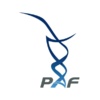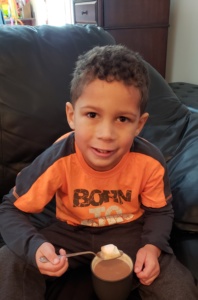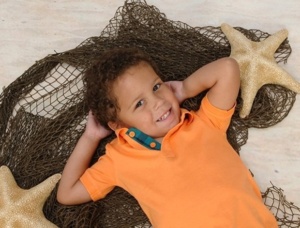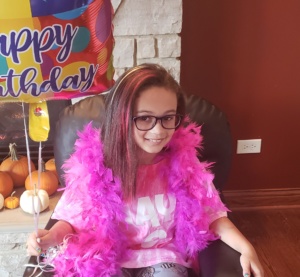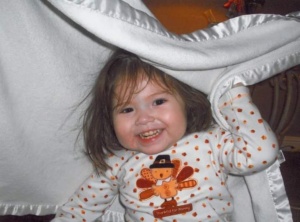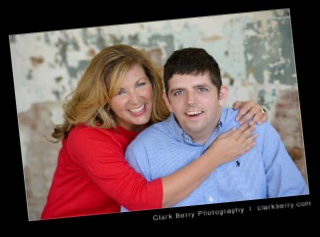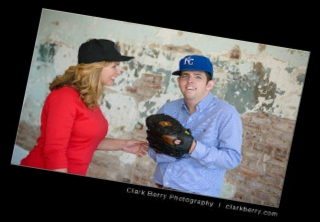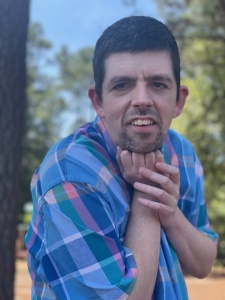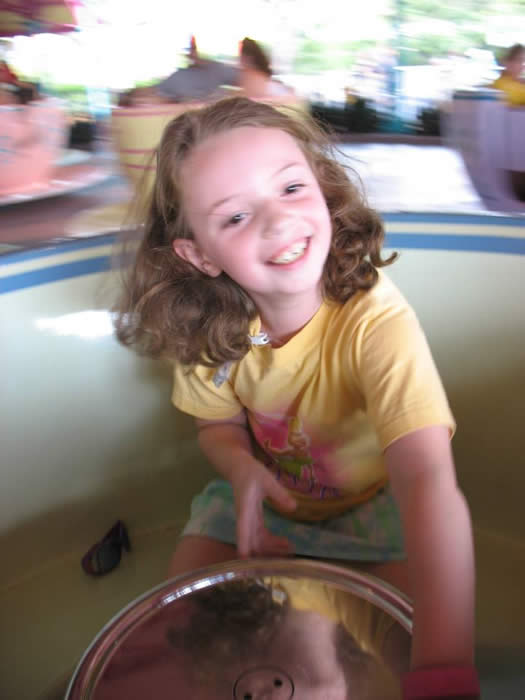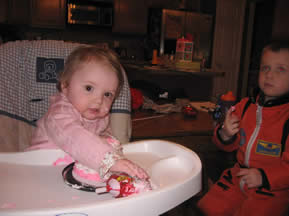Dylan J | Propionic Acidemia | Age 2 1/2
Dylan J sa născut în octombrie 12lea, 2013 în Waconia, Minnesota, cantarind 8 lire sterline, 2 ounces. Dupa ce Dylan a fost născut, medicii au observat că el a avut o decât temperatura medie a corpului inferior, așa că l-au adus înapoi la grădiniță să-l încălzească. El a fost adus înapoi la noi, și de acolo timp de doua zile, am experimentat o normală, băiat sănătos mic, sau așa ne-am gândit.
În primele ore ale dimineții octombrie 15lea, numai 15 ore de când am fi fost externat din spital, ca o familie de 3, Dylan a fost un fel de ciudat în calitate. El a fost foarte somnoros, și părea rece la atingere. Soțul meu, Adam, și i-am luat temperatura lui și el a fost la 95 degrees. Știind că nu era normal, Am sunat sora mea- în- lege, care este o asistentă medicală NICU aici în orașe, și ea ne-a spus să încerce a face-piele pe piele să-l încălzească, și în cazul în care nu a funcționat, pentru a apela, probabil, medicul pediatru de gardă. Spre uimirea noastră, o oră a trecut și nu sa încălzit deloc, chiar și după tot ce am încercat. Am sunat pediatru de gardă și el ne-a spus să-l urmărească în următoarele câteva ore, dacă el era încă rece și era încă foarte letargic și nu a vrut să mănânce, am putea aștepta să-l aducă la birou pediatru, care sa deschis la 8am acea dimineață, sau am putea să-l aducă la camera de urgență. Cam după o oră, soțul meu a luat Dylan până să-l aducă la mine pentru a încerca și hrana pentru animale, iar brațele lui au căzut fără vlagă în spatele corpului său. Este o imagine care este ars în mintea mea. Am știut în acel moment ceva a fost greșit, așa că l-am ambalat în scaunul mașina lui și l-au dus la camera de urgență. Odata acolo, L-au uitat peste, și ne-a spus că, deoarece bebelușii nu ne poate spune ce sa întâmplat, ei ar trebui să facă mai multe teste de sange si un robinet spinarii pentru a restrânge ceea ce se întâmplă. Îmi amintesc de doctorul ER spunându-ne că a fost greu sa ma uit la copiii mici se înțepate așa că ne-a spus să meargă să aștepte într-o altă cameră (Nu știam că s-ar prezenta mult mai rău că aceste Înghiontelile în viața lui Dylan să vină). respirație Dylan, de asemenea, a început să devină extrem de greu, el a fost într-adevăr încearcă din greu pentru a obține fiecare respirație și în afară. Nu-mi amintesc cât de mult timp am fost în cameră, dar îmi amintesc doctorul vine și spunându-soțul meu și eu, ei nu au avut nici un rezultat înapoi încă, dar ei au crezut că este nevoie să fie transferat într-un spital de copii din centrul orașului Minneapolis, să-l pună pe un ventilator, pentru că era prea epuizată de lucru atât de greu să respire. El a părăsit camera, și l-am pierdut, un ventilator, pentru micul meu copil? Ce a fost gresit? Mai târziu, doctorul s-au întors și a spus, de fapt, el a crezut că ar putea fi în măsură să încerce doar oxigen, astfel încât acestea au fost să-l transferă la etaj, la NICU lor, pentru a vedea dacă am putea obține sub control.
Atunci, că jocul de așteptare a început. Au facut mai multe teste de sânge, la un moment dat vine la concluzia că el a fost doar deshidratat. de zahăr din sânge său a fost foarte scăzută, și au crezut că pur și simplu nu a mâncat suficient. Ore au trecut prin, și am fost de așteptare pentru neonatolog care a făcut runde sale în jurul valorii de spitale mai suburbane, pentru a ajunge si uita-te la Dylan. În jurul valorii de timp masa de prânz, doctorul a venit și sa uitat la el și ne-a spus că a crezut Dylan încă mai este nevoie să fie transferat la spitalul de copii care urmează să fie pus pe un ventilator, deoarece oxigenul în sine nu a fost ea de tăiere. In timp ce el ne spune acest lucru, o asistentă medicală a intrat în, ia dat o bucată de hârtie, la care sa uitat la, a răspuns "oh, Doamne", și a părăsit sala. Am fost speriat, dar nu cred că prea mult din ea. Câteva minute mai târziu a venit din nou și ne-a spus că nivelul de amoniac Dylan a fost 900. Se uită la fețele noastre foarte confuz și ne-a spus că acest lucru a fost foarte, foarte serios, că intervalul normal a fost 10-35, și că Dylan nu-l poate face. Îmi amintesc fiind amortit, la ideea că noul meu copil ar putea muri, când o oră mai devreme ne-am gândit că era deshidratat. Doctorul a plecat să înființeze o ambulanță ca să Dylan, nu la spitalul de copii mai, dar la spital Universitatea din Minnesota pentru copii, deoarece avea nevoie de un tratament special, disponibil numai la Universitatea. Trebuia să fie pus pe dializa.
Am mers în ambulanță cu Dylan, iar cele care au fost cel mai lung 45 minute din viața mea. Îmi amintesc că gândeam că va muri în ambulanță, că nu era nimic am putut face, Tocmai am trebuit să stea pe scaunul din față și rugați-vă. Odată ce am ajuns la spital, era ca o scenă dintr-un film, toti acesti medici ne misunau, mi-a spus că ar aștepta, explica ce se întâmplă, au nevoie de mine să semneze formularele de aprobare pentru a începe dializa. Telling me that doing dialysis on a 3 day old baby was very risky, but what other choice did we have? By the time we arrived at the hospital his ammonia had climbed to 1200. My husband and I, and our families, were ushered into the family waiting room where we waited to hear word on Dylan. It was at this time we were introduced to our metabolic doctor. She came and met with us and described what she believed Dylan had. A rare genetic disorder, where he could not break down protein correctly, and instead of breaking it down, he would only break down to a certain point and then the bad things (propionic acid and ammonia), would back up in his system. With it being as high as it was, it was poisoning his organs. Ne-au spus ei credeau creierul lui era umflat și nu au putut fi siguri ce leziuni ale creierului, el a primit de la amoniac ridicat, ei ar lua un RMN și ultrasunetelor, care ambii au ieșit destul de bună, dar, într-adevăr timp s-ar spune.
Multe ore mai târziu, dializa a început, și o asistentă medicală a venit, și a spus cuvintele, Nu voi uita niciodată "Știu că acest lucru a fost cea mai proastă zi din viața ta, dar am vrut să-ți dau niște vești bune, amoniac Dylan este de 90 "! La fel de repede ca el sa îmbolnăvit, el a luat mai bine la fel de repede. Ei au fost capabili să grăbească rezultatele screening-ul nou-nascuti Dylan si care a confirmat diagnosticul de acidemia propionic. Medicii au avut acum un diagnostic și au putut să-l trateze. Pe măsură ce zilele trecute in UTI, amoniacul sa stabilizat, ei au putut să-l înceapă cu o dieta saraca in proteine de Propimex si laptele matern, și a făcut într-adevăr bine. Noi am fost în stare să meargă acasă după doar 7 zile in UTI.
Viata cu Dylan, după ce părea să meargă foarte bine, și pentru noi a fost "normal". A fost un bun mancator, a mâncat întotdeauna cantitatea de proteine si calorii de care avea nevoie pentru a obține într-o zi și a fost în curs de dezvoltare, în mod normal. Mi-ar verifica cetonelor lui în urina lui de zi cu zi (medicii noștri crezut că am fost un pic nebun pentru a verifica atât de mult, dar a fost indicatorul meu ceva a fost oprit), și au fost întotdeauna negative, până când el a fost de aproximativ 5 months old. Dylan a început obtinerea urme la cetone mici în urina lui aproape zilnic. Ne-ar încerca să împingă mai multe lichide, dar ei s-ar merge în continuare înapoi în sus. Mânca toate sticlele sale foarte bine încă și acționează complet normal. Totuși, odată ce am văzut ketones, noi l-ar aduce la camera de urgență și amoniacul său ar fi ridicat, în anii 100. Partea cea mai înspăimântătoare a fost, el nu a acționat diferit, nu a prezentat semne de amoniac său a fost ridicat, cu excepția cetonele.
După ce a fost în și în afara din spital, timp de săptămâni, la un moment dat între februarie și mai, doctorii noștri metabolice au decis să-l înceapă pe Carbaglu, pentru a ajuta la menținerea lui amoniac sub control. Când am fost externat din spital, la sfârșitul lunii aprilie după începerea Carbaglu, ne-am întâlnit pentru o urmarire întâlnire cu medicii noștri metabolice. Acesta a fost la această întâlnire că doctorul Dylan ne-a stat în jos și ne-a spus că a crezut Dylan avea nevoie de un transplant de ficat. Vezi, ei n-au putut să ne spună sigur dacă Dylan a avut un caz mai severe de PA sau nu, pentru că după ce sa făcut testarea genetica, a revenit ca ambele mutatii sale nu au fost niciodată văzut înainte. Așa că ne-am cam trebuit să așteptăm și să vedem cum a făcut-o. Am fost șocați, nu a avut niciodată am crezut că transplantul de ficat ar fi ceva ce ar fi discutat pentru Dylan. Soțul meu și m-am dus acasă și pentru câteva săptămâni gândit la asta, s-au rugat cu privire la aceasta, strigă despre ea, cercetat-l, povestiri au primit de la alți părinți care au trecut prin această, și în cele din urmă a decis că nu am vrut să aștepte până când o altă criză sa întâmplat lui Dylan și a avut leziuni ale creierului sau mai rau, am vrut Dylan să rămână Dylan. Deci, pe mai 8lea din acest an, când Dylan a fost 7 months old, am plasat Dylan pe lista de transplant pentru a obține un nou ficat.
On July 24lea, am primit chemarea pe care au avut un ficat nou pentru Dylan. Am renuntat ceea ce făceam și alergat la spital, unde au făcut toate lucrările pregătitoare pre-intervenție chirurgicală, ne-au pregătit, și a așteptat un cuvânt ca atunci când organul ar fi în Minnesota, iar atunci când o intervenție chirurgicală va începe. On July 26lea, intervenție chirurgicală sa întâmplat. Soțul meu și am mers pe Dylan în jos la camera de pre-op și l-au predat la echipa de transplant. Am fost ghidat în sala de așteptare de familie în cazul în care ne-am așteptat cu familiile noastre pentru 8 foarte multe ore lungi. Atunci când chirurgul a ieșit, cu un zâmbet pe fața lui, și ne-a spus că a mers foarte bine, a fost o astfel de ușurare. Am fost luat la Picu, unde am putut vedea Dylan, și la fel de speriat ca am fost să-l văd, atunci când am făcut-o, el arăta atât de bine. da, el a fost cuplat la atât de multe tuburi și linii, și el a fost umflat, dar el a privit la fel ca băiatul nostru. Am stat în spital pentru 18 zile recuperate Dylan. Corpul lui a acceptat noul ficat foarte bine, și unul dintre cele mai bune momente ale vieții noastre, a fost atunci când medicul nostru metabolic a venit și ne-a spus că testele de acizi organici care le-au luat pe Dylan, după o intervenție chirurgicală a arătat că nu a avut nici de acid propionic în corpul său! Ce miracol.
A fost aproape 2 ani de când Dylan a avut transplantul și el face fantastic. A avut câteva complicații, dar, deoarece el a trecut prin ele cu culori care zboară. Dylan va fi pe anti-respingere medicamente pentru toată viața. Există teama că el poate intra în respingerea în orice moment, dar daca este prins destul de devreme, este foarte tratabile. Și aici, în Minnesota, cu medicii noștri, ei vor păstra un ochi foarte aproape de el. De asemenea, nu au multe cercetări cu privire în cazul în care ficatul va dura toată viața lui, sau în cazul în care ar avea nevoie de unul nou în cele din urmă, dar in acelasi timp, nu avem o tona de date cu privire la ceea ce face AP pe termen lung organism. Medicii noștri metabolice sunt foarte precaut cu el, l-au continuat cu formula lui metabolică doar până la această octombrie anul trecut, când am încercat să vedem ce-a făcut laboratoarele sale, dacă a plecat de pe ea și până acum el a rămas stabil. El este în continuare pe o dieta de proteine restricționat, chiar acum el devine 30-35g pe zi. Schimbarea în el de transplant a fost de zece ori. Înainte de a avea ton scăzut și acum tonul lui este atât de mult mai bine, el conduce și urcă la fel ca orice 2 ½ în vârstă de ani, când vom juca la parc! Cu toate că a fost cea mai grea decizie pe soțul meu și l-am făcut vreodată, aceasta a fost decizia corecta pentru noi, am vrut Dylan să conducă cea mai bună viață el ar putea, și chiar dacă au existat atât de multe riscuri, și noi nu știm 100% ceea ce viitorul va organiza, a meritat, pentru că el este un astfel de fericit și foarte sănătos 2 ½ ani mic băiat!
